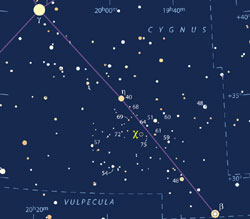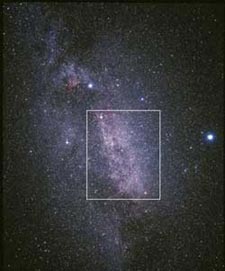
This chart shows the location of Chi Cygni within the neck of Cygnus, the Swan. The numbers near other stars are their visual magnitudes to the nearest tenth (with the decimal points omitted) for comparison. Use them to estimate Chi's magnitude each night you take a look.
Data: Millennium Star Atlas, AAVSO.
Cygnus is a well-known summer constellation, with its distinctive "cross" shape. In early July the Swan's neck will contain an "extra" star — the long-period variable Chi (c) Cygni, currently rising toward maximum brightness.
Chi Cygni is one of the brightest and best-known of the red long-period variable stars (Mira stars) with a period of about 408 days. In July 1686, Gottfried Kirch at Berlin noticed that the star was missing from the sky. Not until October of that year did the star resume its place along the neck of Cygnus, the Swan. Astronomers have been following its variations ever since.
Chi's brightness rises rapidly and typically peaks near magnitude 5.2, but the maximum can be up to two magnitudes brighter or fainter. The next is due around July 11, 2005, according to the 2005 edition of the Observer's Handbook of the Royal Astronomical Society of Canada. Tracking its changes is a fine project for binocular skywatchers; Chi’s orange-red hue helps to identify this variable. After maximum Chi Cygni should remain visible for a few weeks as it slowly fades back toward its minimum brightness.

Thousands of stars crowd this image of the Northern Cross; the bright star Vega is visible to the right. The rectangle encloses the area covered by the star chart.
Courtesy Akira Fujii.
Chi Cygni is in the long part of the Northern Cross, 3/5 of the way from 2.2-magnitude Gamma (g) to 3.0-magnitude Beta (b) Cygni. Use the chart (above) to find this star; it includes the visual magnitudes (to tenths, with decimal point omitted) of nearby comparison stars.
Use our
interactive sky chart
to locate Cygnus in the late evening sky and determine when it rises for your observing site. Note that the chart is set for 40° north latitude (for central North America) at 2:00 a.m. daylight saving time on June 11th (a month before maximum). To alter these parameters, click the "change" buttons beside the "Location" and "Date & Time" labels on the chart.
 0
0
Comments
You must be logged in to post a comment.